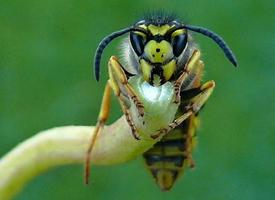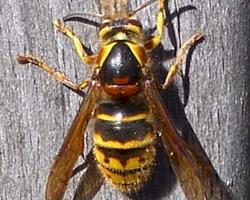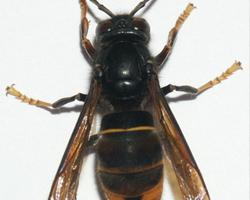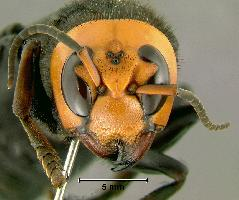
Greutăți și măsuri
| Lungime | de la 20 la 25 mm |
|---|
Descrierea animalului
The European hornet, scientifically known as Vespa crabro, is a striking example of the Vespidae family, which includes wasps and hornets. Native to Europe, Asia, and parts of Africa, this species has also been introduced to North America, where it has adapted to various environments. The European hornet is the largest eusocial wasp native to Europe, with queens measuring up to 35mm in length, and workers slightly smaller, ranging from 18 to 25mm.Distinguished by its size and coloration, the European hornet possesses a robust body that is a blend of reddish-brown, yellow, and black hues. The head is large, with prominent mandibles and two large compound eyes that are complemented by three simple eyes on the top. Its thorax and abdomen exhibit a striking pattern, with the former being reddish-brown and the latter showcasing yellow and black stripes, which serve as a warning to predators about its potential to sting.
The European hornet's wings, which have a reddish-brown tinge, are another remarkable feature, contributing to its intimidating appearance. Despite their size, these insects are capable of agile flight, which they use to hunt, forage, and scout for potential nesting sites.
Nesting habits of Vespa crabro are fascinating; they prefer to build their nests in dark, secluded areas, such as hollow trees, attics, or abandoned burrows. The nests are constructed from a paper-like material, which is made by chewing wood fibers mixed with saliva. These nests can become quite large by the end of the summer, housing hundreds of individuals, including the queen, workers, and males.
The European hornet is omnivorous, with a diet that includes other insects, tree sap, and fruit. They play a pivotal role in the ecosystem as both predators and pollinators. As predators, they help control populations of pests such as flies and caterpillars. However, their habit of foraging on fruit and nectar also contributes to the pollination of plants.
Social structure within a European hornet colony is complex and hierarchical, with a single reproductive queen, sterile female workers, and males, known as drones. The queen is the only female that reproduces, laying eggs that develop into the next generation of workers and, later in the season, males and new queens.
Despite their fearsome reputation, European hornets are not typically aggressive towards humans unless provoked. Their sting, while painful, is less toxic than that of some other wasp species. However, individuals with allergies to insect stings should exercise caution around them.
In recent years, the presence of the European hornet has sparked interest and concern due to its potential impact on native ecosystems, particularly in regions where it has been introduced. Conservation efforts and studies continue to monitor its influence and promote a balance between these newcomers and the indigenous species.
The European hornet, with its distinctive appearance, complex social structure, and ecological role, is a fascinating subject of study for entomologists and nature enthusiasts alike. Its presence in the natural world is a testament to the intricate web of life and the ongoing dance between species in their shared environments.
Animale similare
Fotografii noi cu animale
Top 10 animale
- Dolphin gull (Leucophaeus scoresbii)
- Diana monkey (Cercopithecus diana)
- Moustached guenon (Cercopithecus cephus)
- Galápagos tortoise (Geochelone nigra complex)
- Stone loach (Barbatula barbatula)
- Greek tortoise (Testudo graeca)
- Japanese macaque (Macaca fuscata)
- Russian tortoise (Testudo horsfieldii)
- Common flying dragon (Draco volans)
- Galápagos penguin (Spheniscus mendiculus)


